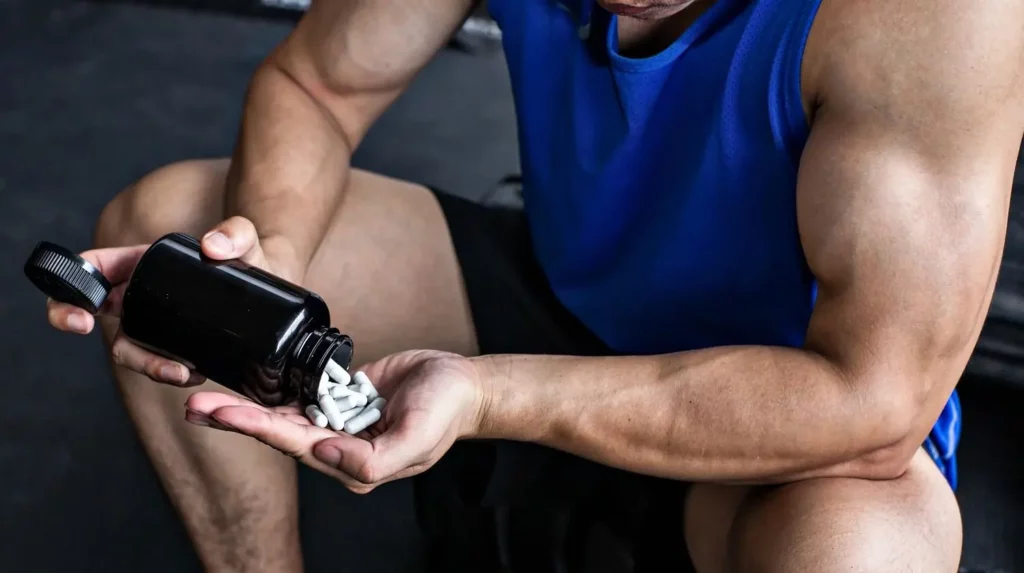Anabolic-androgenic steroids (AAS), synthetic derivatives of testosterone, are known for their use in building muscle and enhancing performance. However, their role in dermatology often goes unrecognized. They possess both anabolic properties, which facilitate growth and bone density improvements, and androgenic effects, relating to the development and maintenance of masculine characteristics. This dual nature allows them to play a unique part in the treatment of certain skin conditions when used under medical supervision.
In dermatology, the therapeutic applications of anabolic steroids are leveraged to treat a variety of skin conditions, such as severe burns, certain kinds of chronic ulcers, and some inflammatory disorders. These conditions may benefit from the steroids’ ability to accelerate tissue repair and regeneration. On the other hand, non-prescription use of AAS for aesthetic enhancement can lead to adverse dermatological effects, ranging from acne to more severe skin disorders. Therefore, understanding the balance between therapeutic potential and the risk of side effects is critical for both healthcare professionals and patients.
Quick Summary
- Anabolic steroids have applications in dermatology for tissue repair and treatment of specific skin conditions.
- Non-medical use of anabolic steroids can lead to a variety of skin-related side effects.
- Balancing the dermatological benefits against potential risks is crucial for safe therapeutic use.
Anabolic Steroids and Their Dermatological Impact

Anabolic-androgenic steroids (AAS) have notable effects on skin tissue, with implications for both therapeutic and harmful outcomes.
Biological Role of Anabolic-Androgenic Steroids
Anabolic steroids, also known as anabolic-androgenic steroids (AAS), are synthetic derivatives of testosterone that promote anabolism—the process of building cellular tissue, particularly muscle. They exhibit both anabolic (tissue-building) and androgenic (masculinizing) effects, but their impact on skin physiology is primarily tied to their androgenic activity. Androgen receptors, located in various body tissues, including the cutaneous structures, mediate the effects of anabolic steroids.
In the realm of dermatology, the skin’s sebaceous glands are particularly sensitive to hormonal changes, specifically to androgens. AAS bind to androgen receptors in these glands, which can alter sebum production and composition. This can affect skin conditions like acne or oily skin, where altered sebum production has a direct impact on the severity and incidence of these conditions.
Mechanism of Steroidal Action on Skin
Anabolic-androgenic steroids exert their influence on the skin through the androgen receptors. Once AAS bind to these receptors, they activate a series of cellular events that can alter the normal function of skin cells.
One key action is the stimulation of sebaceous glands to produce more sebum, an oily substance that helps lubricate and protect the skin. This overstimulation often leads to acne formation, which is especially common among AAS users. Additionally, AAS can influence the hair follicles, leading to changes in hair growth patterns, which might result in conditions such as hirsutism or male-pattern baldness in predisposed individuals.
- Sebaceous Gland Activation: Increased sebum production and potential acne.
- Hair Follicle Stimulation: Changes in hair growth, which may cause hirsutism or baldness.
- Skin Texture: Potentially altered skin hydration and texture due to changed sebaceous gland activity.
When their application is supervised medically, AAS can be used to treat various skin conditions that are responsive to androgens. However, unsupervised or excessive use can lead to dermal side effects that may require intervention.
Common Dermatological Conditions Associated with Steroid Use

Anabolic steroid use, whether systemic or topical, can contribute to various skin conditions. These concerns often manifest as acne and related eruptions, heightened risk of infections, and changes in skin texture and healing.
Acne and Acneiform Eruptions
Anabolic steroids can cause acne vulgaris, a condition characterized by blackheads, whiteheads, and inflamed pimples. More severe cases might escalate to acne fulminans, an abrupt onset of acne characterized by system symptoms like fever and joint pain. The steroids increase sebum production, skin cell turnover, and inflammation, facilitating an environment where Cutibacterium acnes bacteria can thrive.
Skin Infections and Folliculitis
Steroid use is linked to an increased risk of skin infections due to compromised skin barrier function. Folliculitis, the inflammation of the hair follicles, can occur following system or topical steroid use. This often appears as clusters of small red bumps that may develop into pus-filled blisters.
Altered Healing and Striae Distensae
Steroids may also affect the skin’s healing capabilities, leading to atrophy or thinning. This can result in striae distensae, the medical term for stretch marks. These marks typically form due to rapid stretching of the skin and are quite common on the shoulders and sides of the body due to muscle growth induced by steroids.
Risks and Adverse Effects of Anabolic Steroids

While anabolic steroids can be used to treat certain skin conditions, their potential risks and adverse effects on psychological health and systemic organs cannot be ignored. They can induce significant side effects, particularly in non-medical, abusive scenarios.
Psychological and Emotional Impact
Anabolic steroid use is linked with a range of psychological effects. Users may experience mood swings and heightened aggression commonly referred to as “roid rage.”
- Depression and anxiety can also ensue, both while using steroids and during withdrawal periods.
- These substances have been associated with dependence, leading to potential drug abuse.
- The central nervous system may be affected, altering the user’s behavior and emotional state.
Systemic Health Risks
The non-dermatological side effects of anabolic steroids pose considerable systemic health risks.
- Liver: Their use can lead to liver abnormalities and tumors, with users being at risk of peliosis hepatis, a condition where blood-filled cysts form in the liver.
- Heart: The cardiological effects are significant and include hypertension, changes in blood lipids, and an increased risk of sudden cardiac death.
Dermatological side effects comprise acne, accelerated hair loss in those predisposed to male pattern baldness, and oily skin. It’s imperative for users to recognize these dangers and weigh the benefits against the potential risks of anabolic steroid use.
Treatment and Management of Dermatologic Conditions

Anabolic steroids play a pivotal role in dermatology for treating several skin conditions, though their use requires careful management to avoid adverse effects.
Medical Interventions and Prescriptions
Physicians often prescribe systemic steroids like prednisone to manage inflammatory dermatologic conditions. For severe acne, oral isotretinoin is a common prescription aimed at reducing oil gland activity, inflammation, and bacterial growth, thereby mitigating the risk of permanent scarring. Dosages of isotretinoin are tailored by dermatologists to effectively treat the severity of the condition while monitoring for side effects.
| Medication | Purpose | Typical Use Case |
|---|---|---|
| Systemic steroids | To reduce inflammation and suppress immune responses | Dermatitis, eczema, psoriasis |
| Oral isotretinoin | To inhibit sebaceous gland function and cell turnover | Severe nodular acne |
Lifestyle Modifications and Supportive Care
In tandem with medical treatments, patients are advised to adopt certain lifestyle changes to enhance their treatment outcomes. These can include a regimented skincare routine, stress reduction techniques, and diet modifications targeting low glycemic indices. Supportive care, such as regular follow-up appointments with their dermatologist, ensures personalized treatment adjustments are made as necessary.
- Skincare Routine: Gentle cleansing, non-comedogenic moisturizers
- Diet: Avoidance of high glycemic foods
- Stress Management: Techniques like mindfulness or yoga
References
- On the use of systemic steroids: https://www.ncbi.nlm.nih.gov/pmc/articles/PMC3579488/
- Regarding isotretinoin’s uses and guidelines: https://www.aad.org/member/clinical-quality/guidelines/acne
Prevention, Education, and Regulation

Anabolic androgenic steroids (AAS) are often misused for their muscle-building effects, but such misuse can lead to serious health outcomes. Creating awareness and establishing robust regulations are crucial for preventing AAS abuse, particularly among young adults, athletes, and bodybuilders.
Awareness and Outreach Efforts
Outreach programs are essential to educate the public about the risks of AAS abuse and the importance of maintaining a positive body image without resorting to harmful substances. Campaigns led by health organizations and sports authorities often target social media platforms, since these have a significant influence on young adults. They provide resources and support for those struggling with steroid addiction and promote healthy lifestyle choices.
- Target Groups: Athletes, bodybuilders, young adults
- Platforms Used: Instagram, Twitter, Facebook
- Key Messages: Risks of AAS abuse, promotion of natural bodybuilding
Legal and Sporting Regulations
The World Anti-Doping Agency (WADA) has set stringent regulations to deter AAS abuse in sports. These rules are enforced through regular drug testing and severe penalties for non-compliance, including suspensions and bans.
- Penalties for AAS Abuse:
- First offense: Up to 4 years ban
- Subsequent offenses: Life ban
- WADA’s Role:
- Regular drug testing
- Updating the prohibited substances list
- Impact on Sports: Creates a level playing field, deters AAS misuse
Frequently Asked Questions

Anabolic steroids can cause several skin-related side effects, some of which may persist even after cessation of use. Understanding these effects is critical for individuals considering or currently using anabolic steroids.
What are the dermatological side effects associated with anabolic steroid use?
Anabolic steroids can lead to oily skin and increase the likelihood of skin infections due to overstimulated sebaceous glands. Individuals may also experience skin atrophy, striae, and delayed wound healing.
Can anabolic steroids lead to acne or other skin conditions?
Yes, anabolic steroids can cause acneiform eruptions, often characterized as steroid acne. The condition is commonly observed on the chest, back, and shoulders.
What impact do anabolic steroids have on facial skin?
The use of anabolic steroids may result in increased facial oiliness and the development of acne, particularly severe forms such as cystic acne. Facial hair growth in women, also known as hirsutism, can occur too.
Are there any long-term skin complications from taking anabolic steroids?
Long-term use of anabolic steroids can lead to permanent skin changes, including deep acne scars and hyperpigmentation. Long-term users may also experience a thinning of the dermal layer.
How can anabolic steroids affect hair health and condition?
Anabolic steroids can exacerbate male pattern baldness in those genetically predisposed due to their conversion to dihydrotestosterone (DHT), a potent androgen. They may also cause increased body hair growth.
What skin reactions should one be aware of when using anabolic steroids?
Individuals should be vigilant for signs of allergic reactions or local skin irritation where anabolic steroids are applied topically. These reactions can include redness, itching, swelling, and rashes.
References
Dr. Grant Fourie, a specialist in male hormones, is based in Cape Town, South Africa. He provides comprehensive treatments for conditions related to low testosterone, such as erectile dysfunction, fatigue, and mood changes. His methods include hormone replacement therapy and other modern treatment options.
Contact me via email or phone to book personal appointment in my clinic: The Village Square, Cape Town - South Africa



